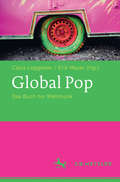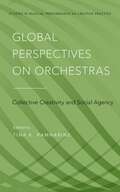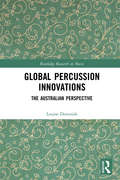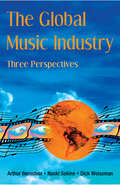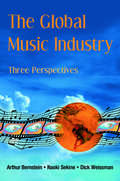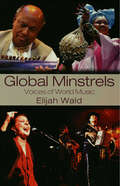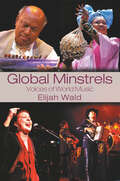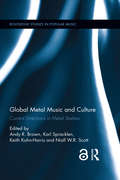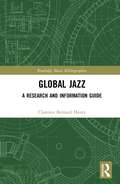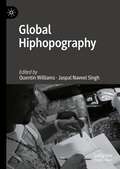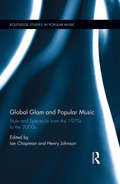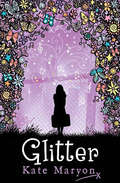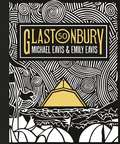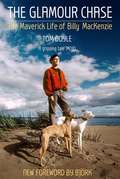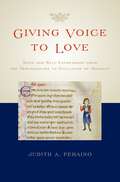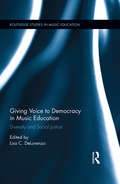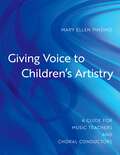- Table View
- List View
Global Pop: Das Buch zur Weltmusik
by Claus Leggewie Erik Meyer„Global Pop“ beschreibt in mehr als vierzig Beiträgen das Phänomen "Weltmusik" in seiner ganzen Breite, ordnet es historisch ein und schließt es an aktuelle kulturwissenschaftliche Diskussionen an. Das Buch führt in zentrale Begriffe ein und bietet eine anschauliche Beschreibung von charakteristischen Akteuren und musikalischen Genres. Neben den Künstlern gilt das Interesse auch exemplarischen Figuren, die für die Vermittlung von Weltmusik stehen. Darüber hinaus sind die kulturpolitischen sowie musikwirtschaftlichen Infrastrukturen von Weltmusik in Deutschland Thema. Auch der Name “Weltmusik” wird aus verschiedenen Perspektiven diskutiert, problematisiert und inklusive aktueller Entwicklungen einer “Weltmusik 2.0” verstanden, die durch Digitalisierung und Online-Kommunikation geprägt ist.
Global Perspectives on Orchestras: Collective Creativity and Social Agency (Studies in Musical Perf as Creative Prac)
by Tina K. RamnarineOffering innovative approaches to thinking about orchestras, Global Perspectives on Orchestras: Collective Creativity and Social Agency adopts ethnographic, historical and comparative perspectives on a variety of traditions, including symphony, Caribbean steel, Indonesian gamelan, Indian film and Vietnamese court examples. The volume presents compelling analyses of orchestras in their socio-historical, economic, intercultural and postcolonial contexts, while emphasizing the global and historical connections between musical traditions. By drawing on new ethnographic and historical data, the essays describe orchestral creative processes and the politics shaping performance practices. Each essay considers how musicians work together in ensembles, focusing on issues such as training, rehearsal, creative choices, compositional processes, and organizational infrastructures. Testimonies of orchestral musicians highlight practitioners' views into the diverse world of orchestras. As a whole, the volume discusses the creative roles of performers, arrangers, composers and arts agencies, as well as the social environments supporting musical collaborations. With contributions from an international team of researchers, Global Perspectives on Orchestras offers critical insights gained from the study of orchestras, collective creativity and social agency, and the connections between orchestral performances, colonial histories, postcolonial practices, ethnographic writings and comparative theorizations.
Global Perspectives on Orchestras: Collective Creativity and Social Agency (Studies in Musical Perf as Creative Prac)
Offering innovative approaches to thinking about orchestras, Global Perspectives on Orchestras: Collective Creativity and Social Agency adopts ethnographic, historical and comparative perspectives on a variety of traditions, including symphony, Caribbean steel, Indonesian gamelan, Indian film and Vietnamese court examples. The volume presents compelling analyses of orchestras in their socio-historical, economic, intercultural and postcolonial contexts, while emphasizing the global and historical connections between musical traditions. By drawing on new ethnographic and historical data, the essays describe orchestral creative processes and the politics shaping performance practices. Each essay considers how musicians work together in ensembles, focusing on issues such as training, rehearsal, creative choices, compositional processes, and organizational infrastructures. Testimonies of orchestral musicians highlight practitioners' views into the diverse world of orchestras. As a whole, the volume discusses the creative roles of performers, arrangers, composers and arts agencies, as well as the social environments supporting musical collaborations. With contributions from an international team of researchers, Global Perspectives on Orchestras offers critical insights gained from the study of orchestras, collective creativity and social agency, and the connections between orchestral performances, colonial histories, postcolonial practices, ethnographic writings and comparative theorizations.
Global Percussion Innovations: The Australian Perspective (Routledge Research in Music)
by Louise DevenishFirst emerging in North America and Europe in the late 1920s, contemporary percussion practices have transitioned from the fringes of contemporary music to the forefront over the past 90 years. In the 1960s contemporary percussion practices reached Australian shores and a new generation of artists added their voices to this narrative. The role of Australian activity is not yet embedded in the wider narrative of international contemporary percussion, nor is the significance of developments in contemporary percussion practices fully realised in the context of Australian music history. In this monograph, political, social and cultural influences on this art form will be examined for the first time in a historical survey of contemporary percussion music in Australia over a 50-year period, from 1960 to 2010. The rise of the percussion ensemble in the twentieth century to a standard chamber music ensemble is now recognised as one of the major advances in western art music practice internationally. A focus will be placed on ensemble activity via definitive documentation and analysis of ensembles that are amongst the most pioneering and longest established of Australian contemporary music organisations, including the Australian Percussion Ensemble, Synergy Percussion, Adelaide Percussions, Nova Ensemble, Tetrafide Percussion, Taikoz, Clocked Out and Speak Percussion amongst others. Closing with a discussion of influences and identity, this historical narrative will expand our understanding of the impact of Australian contributions to the international contemporary music scene while simultaneously examining how developments in contemporary percussion have contributed to Australia’s cultural identity.
Global Percussion Innovations: The Australian Perspective (Routledge Research in Music)
by Louise DevenishFirst emerging in North America and Europe in the late 1920s, contemporary percussion practices have transitioned from the fringes of contemporary music to the forefront over the past 90 years. In the 1960s contemporary percussion practices reached Australian shores and a new generation of artists added their voices to this narrative. The role of Australian activity is not yet embedded in the wider narrative of international contemporary percussion, nor is the significance of developments in contemporary percussion practices fully realised in the context of Australian music history. In this monograph, political, social and cultural influences on this art form will be examined for the first time in a historical survey of contemporary percussion music in Australia over a 50-year period, from 1960 to 2010. The rise of the percussion ensemble in the twentieth century to a standard chamber music ensemble is now recognised as one of the major advances in western art music practice internationally. A focus will be placed on ensemble activity via definitive documentation and analysis of ensembles that are amongst the most pioneering and longest established of Australian contemporary music organisations, including the Australian Percussion Ensemble, Synergy Percussion, Adelaide Percussions, Nova Ensemble, Tetrafide Percussion, Taikoz, Clocked Out and Speak Percussion amongst others. Closing with a discussion of influences and identity, this historical narrative will expand our understanding of the impact of Australian contributions to the international contemporary music scene while simultaneously examining how developments in contemporary percussion have contributed to Australia’s cultural identity.
The Global Music Industry: Three Perspectives
by Arthur Bernstein Naoki Sekine Dick WeissmanFor everyone in the music industry—record labels, managers, music publishers, and the performers themselves—it is important to understand the world music marketplace and how it functions. Yet remarkably little has been written about the music business outside of the U.S. The Global Music Industry: Three Perspectives gives a concise overview of the issues facing everyone in the international music industry. Designed for an introductory course on music business, the book begins with an introduction to the field around the world, then focuses on global issues by region, from bootlegging and copyright to censorship and government support. It will be a standard resource for students, professionals, and musicians.
The Global Music Industry: Three Perspectives
by Arthur Bernstein Naoki Sekine Dick WeissmanFor everyone in the music industry—record labels, managers, music publishers, and the performers themselves—it is important to understand the world music marketplace and how it functions. Yet remarkably little has been written about the music business outside of the U.S. The Global Music Industry: Three Perspectives gives a concise overview of the issues facing everyone in the international music industry. Designed for an introductory course on music business, the book begins with an introduction to the field around the world, then focuses on global issues by region, from bootlegging and copyright to censorship and government support. It will be a standard resource for students, professionals, and musicians.
Global Minstrels: Voices of World Music
by Elijah WaldAs the fastest growing sector of the U.S. music market, world music has embedded itself in the fabric of American life. Artists such as Peter Gabriel, Paul Simon and the Talking Heads have all utilized characteristics of the "world" sound in their music, while international performers are enjoying unexpected fame in the U.S. At the same time, in an era of unprecedented immigration and globalization, people all over the world are using music as way to preserve their local and ethnic identity. Global Minstrels: Voices of World Music is an accessible introduction to international music and culture. Including conversations with dozens of artists from five continents, it explores the breadth of the world music experience through the voices of the musicians themselves. In the process, it gives a unique view of the interactions of a globalizing society and introduces readers to some of the most fascinating and thoughtful artists working on the current scene. Artists profiled include Oumou Sangare, Caetano Veloso, Ravi Shankar, Paco de Lucía, Ladysmith Black Mambazo, and many more.
Global Minstrels: Voices of World Music
by Elijah WaldAs the fastest growing sector of the U.S. music market, world music has embedded itself in the fabric of American life. Artists such as Peter Gabriel, Paul Simon and the Talking Heads have all utilized characteristics of the "world" sound in their music, while international performers are enjoying unexpected fame in the U.S. At the same time, in an era of unprecedented immigration and globalization, people all over the world are using music as way to preserve their local and ethnic identity. Global Minstrels: Voices of World Music is an accessible introduction to international music and culture. Including conversations with dozens of artists from five continents, it explores the breadth of the world music experience through the voices of the musicians themselves. In the process, it gives a unique view of the interactions of a globalizing society and introduces readers to some of the most fascinating and thoughtful artists working on the current scene. Artists profiled include Oumou Sangare, Caetano Veloso, Ravi Shankar, Paco de Lucía, Ladysmith Black Mambazo, and many more.
Global Metal Music and Culture: Current Directions in Metal Studies (Routledge Studies in Popular Music)
by Keith Kahn-Harris Karl Spracklen Andy R. Brown Niall W.R. ScottThis book defines the key ideas, scholarly debates, and research activities that have contributed to the formation of the international and interdisciplinary field of Metal Studies. Drawing on insights from a wide range of disciplines including popular music, cultural studies, sociology, anthropology, philosophy, and ethics, this volume offers new and innovative research on metal musicology, global/local scenes studies, fandom, gender and metal identity, metal media, and commerce. Offering a wide-ranging focus on bands, scenes, periods, and sounds, contributors explore topics such as the riff-based song writing of classic heavy metal bands and their modern equivalents, and the musical-aesthetics of Grindcore, Doom metal, Death metal, and Progressive metal. They interrogate production technologies, sound engineering, album artwork and band promotion, logos and merchandising, t-shirt and jewellery design, and fan communities that define the global metal music economy and subcultural scene. The volume explores how the new academic discipline of metal studies was formed, also looking forward to the future of metal music and its relationship to metal scholarship and fandom. With an international range of contributors, this volume will appeal to scholars of popular music, cultural studies, and sociology, as well as those interested in metal communities around the world.
Global Metal Music and Culture: Current Directions in Metal Studies (Routledge Studies in Popular Music)
by Keith Kahn-Harris Karl Spracklen Niall Scott Andy R. BrownThis book defines the key ideas, scholarly debates, and research activities that have contributed to the formation of the international and interdisciplinary field of Metal Studies. Drawing on insights from a wide range of disciplines including popular music, cultural studies, sociology, anthropology, philosophy, and ethics, this volume offers new and innovative research on metal musicology, global/local scenes studies, fandom, gender and metal identity, metal media, and commerce. Offering a wide-ranging focus on bands, scenes, periods, and sounds, contributors explore topics such as the riff-based song writing of classic heavy metal bands and their modern equivalents, and the musical-aesthetics of Grindcore, Doom metal, Death metal, and Progressive metal. They interrogate production technologies, sound engineering, album artwork and band promotion, logos and merchandising, t-shirt and jewellery design, and fan communities that define the global metal music economy and subcultural scene. The volume explores how the new academic discipline of metal studies was formed, also looking forward to the future of metal music and its relationship to metal scholarship and fandom. With an international range of contributors, this volume will appeal to scholars of popular music, cultural studies, and sociology, as well as those interested in metal communities around the world.
Global Jazz: A Research and Information Guide (Routledge Music Bibliographies)
by Clarence Bernard HenryGlobal Jazz: A Research and Information Guide is an annotated bibliography that explores the global impact of jazz, detailing the evolution of the African American musical tradition as it has been absorbed, transformed, and expanded across the world’s historical, political, and social landscapes. With more than 1,300 annotated entries, this vast compilation covers a broad range of subjects, people, and geographic regions as they relate to interdisciplinary research in jazz studies. The result is a vivid demonstration of how cultures from every corner of the globe have situated jazz—often regarded as America’s classical music—within and beyond their own musical traditions, creating new artistic forms in the process. Global Jazz: A Research and Information Guide presents jazz as a common musical language in a global landscape of diverse artistic expression.
Global Jazz: A Research and Information Guide (Routledge Music Bibliographies)
by Clarence Bernard HenryGlobal Jazz: A Research and Information Guide is an annotated bibliography that explores the global impact of jazz, detailing the evolution of the African American musical tradition as it has been absorbed, transformed, and expanded across the world’s historical, political, and social landscapes. With more than 1,300 annotated entries, this vast compilation covers a broad range of subjects, people, and geographic regions as they relate to interdisciplinary research in jazz studies. The result is a vivid demonstration of how cultures from every corner of the globe have situated jazz—often regarded as America’s classical music—within and beyond their own musical traditions, creating new artistic forms in the process. Global Jazz: A Research and Information Guide presents jazz as a common musical language in a global landscape of diverse artistic expression.
Global Hiphopography
by Quentin Williams Jaspal Naveel SinghThis book brings together a range of hip hop scholars, artists and activists working on Hip Hop in the Global North and South with the goal of advancing Hiphopographic research as a critical methodology with critical fieldwork methods that can provide a critical perspective of our world. The authors’ focus in this volume is to present an anthology of essays that expand the remit of Hiphopography as an approach to the study of Hip Hop that is not only sensitive to the social, economic, political and cultural lives of Hip Hop Culture participants as interpreters and theorists, but one that continues to humanize the “whole person” behind the decks, on the mic, rocking on the linoleum floor, painting in front of a wall, and seeking that Knowledge of Self. This book will be relevant to Hip Hop scholars in fields such as cultural studies and history, sociolinguistics, linguistic anthropology and ethnography, and race studies, while Hip Hop heads themselves will find parts of this book that represent their culture in ethical and informative ways.
Global Glam and Popular Music: Style and Spectacle from the 1970s to the 2000s (Routledge Studies in Popular Music)
by Henry Johnson Ian ChapmanThis book is the first to explore style and spectacle in glam popular music performance from the 1970s to the present day, and from an international perspective. Focus is given to a number of representative artists, bands, and movements, as well as national, regional, and cultural contexts from around the globe. Approaching glam music performance and style broadly, and using the glam/glitter rock genre of the early 1970s as a foundation for case studies and comparisons, the volume engages with subjects that help in defining the glam phenomenon in its many manifestations and contexts. Glam rock, in its original, term-defining inception, had its birth in the UK in 1970/71, and featured at its forefront acts such as David Bowie, T. Rex, Slade, and Roxy Music. Termed "glitter rock" in the US, stateside artists included Alice Cooper, Suzi Quatro, The New York Dolls, and Kiss. In a global context, glam is represented in many other cultures, where the influences of early glam rock can be seen clearly. In this book, glam exists at the intersections of glam rock and other styles (e.g., punk, metal, disco, goth). Its performers are characterized by their flamboyant and theatrical appearance (clothes, costumes, makeup, hairstyles), they often challenge gender stereotypes and sexuality (androgyny), and they create spectacle in popular music performance, fandom, and fashion. The essays in this collection comprise theoretically-informed contributions that address the diversity of the world’s popular music via artists, bands, and movements, with special attention given to the ways glam has been influential not only as a music genre, but also in fashion, design, and other visual culture.
Global Glam and Popular Music: Style and Spectacle from the 1970s to the 2000s (Routledge Studies in Popular Music)
by Henry Johnson Ian M. Chapman Henry Mabley JohnsonThis book is the first to explore style and spectacle in glam popular music performance from the 1970s to the present day, and from an international perspective. Focus is given to a number of representative artists, bands, and movements, as well as national, regional, and cultural contexts from around the globe. Approaching glam music performance and style broadly, and using the glam/glitter rock genre of the early 1970s as a foundation for case studies and comparisons, the volume engages with subjects that help in defining the glam phenomenon in its many manifestations and contexts. Glam rock, in its original, term-defining inception, had its birth in the UK in 1970/71, and featured at its forefront acts such as David Bowie, T. Rex, Slade, and Roxy Music. Termed "glitter rock" in the US, stateside artists included Alice Cooper, Suzi Quatro, The New York Dolls, and Kiss. In a global context, glam is represented in many other cultures, where the influences of early glam rock can be seen clearly. In this book, glam exists at the intersections of glam rock and other styles (e.g., punk, metal, disco, goth). Its performers are characterized by their flamboyant and theatrical appearance (clothes, costumes, makeup, hairstyles), they often challenge gender stereotypes and sexuality (androgyny), and they create spectacle in popular music performance, fandom, and fashion. The essays in this collection comprise theoretically-informed contributions that address the diversity of the world’s popular music via artists, bands, and movements, with special attention given to the ways glam has been influential not only as a music genre, but also in fashion, design, and other visual culture.
Global Dance Cultures in the 1970s and 1980s: Disco Heterotopias (Palgrave Studies in the History of Subcultures and Popular Music)
by Flora Pitrolo Marko ZubakThis book explores some of disco’s other lives which thrived between the 1970s and the 1980s, from oil-boom Nigeria to socialist Czechoslovakia, from post-colonial India to war-torn Lebanon. It charts the translation of disco as a cultural form into musical, geo-political, ideological and sociological landscapes that fall outside of its original conditions of production and reception, capturing the variety of scenes, contexts and reasons for which disco took on diverse dimensions in its global journey. With its deep repercussions in visual culture, gender politics, and successive forms of popular music, art, fashion and style, disco as a musical genre and dance culture is exemplary of how a subversive, marginal scene – that of queer and Black New York undergrounds in the early 1970s – turned into a mainstream cultural industry. As it exploded, atomised and travelled, disco served a number of different agendas; its aesthetic rootedness in ideas of pleasure, transgression and escapism and its formal malleability, constructed around a four-on-the-floor beat, allowed it to permeate a variety of local scenes for whom the meaning of disco shifted, sometimes in unexpected and radical ways.
Glitter
by Kate MaryonLiberty’s family is super-rich but when her dad loses his job, she has to learn that not all that glitters is gold…A sparkling novel from the author of SHINE.
Glastonbury 50: The Official Story of Glastonbury Festival
by Emily Eavis Michael EavisTHE SUNDAY TIMES BESTSELLERA BOOK OF THE YEAR PICK IN THE TIMES: 'Captivating'A ROUGH TRADE BOOK OF THE YEAR: 'In-depth and inspiring''Beautifully compiled ... the perfect festival experience' THE SUNDAY TIMESGlastonbury 50 is the authorised, behind-the-scenes, inside story of the music festival that has become a true global phenomenon. The story begins in 1970. The day after Jimi Hendrix's death... dairy farmer Michael Eavis invites revellers to his field in Somerset to attend a 'Pop, Folk & Blues' festival. Tickets are £1 each, enticing more than a thousand customers with the promise of music, dance, poetry, theatre, lights and spontaneous entertainment - as well as free milk from his own Worthy Farm cows.Fast forward through five tumultuous decades and the Eavis's vision now encompasses a gigantic 'city in the fields', with a total annual population nearing a quarter of a million. Tickets sell out within minutes, the show is beamed live to more than 40 countries around the globe, and over 3 million people are registered to attend. Meanwhile, the bill has expanded to include big name performers, artists and designers from every branch of the creative arts. Glastonbury Festival is now the largest outdoor green fields event in the world.In their own words, Michael and Emily Eavis reveal the stories behind the headlines, and celebrate 50 years of history in the Vale of Avalon. They're joined by a host of big-name contributors from the world of music - among them Adele, JAY-Z, Dolly Parton, Chris Martin, Noel Gallagher, Lars Ulrich and Guy Garvey. They're joined by artists - Stanley Donwood, Kurt Jackson and many more. Writers - Caitlin Moran, Lauren Laverne, Billy Bragg - and by a host of photographers, from Seventies icon Brian Walker to rock and roll legends Jill Furmanovsky and Greg Williams.Together they bring you the magic that makes Glastonbury, Glastonbury.
The Glamour Chase: The Maverick Life of Billy MacKenzie
by Tom DoyleA first-rate charmer with a devilish twinkle in his eye, Billy MacKenzie was a maverick figure within the music industry whose wild and mischievous spirit possibly did him more harm than good. As frontman of the Associates, gifted with an otherwordly, octave-scaling operatic voice, MacKenzie, together with partner Alan Rankine, enjoyed Top Twenty chart success in 1982. At the height of their success, however, they split. Over the ensuing years, MacKenzie gained a reputation for his unhinged career tactics, generous spirit and knack for squandering large amounts of record-company money. Born in Dundee in 1957 he was the eldest son in a large Catholic family. He was bullied at school and sought refuge in music. He was a schemer and dreamer, a breeder of whippets and a bisexual who kept quiet about his private life. During his lifetime, his unique vocal gift attracted the attention of Shirley Bassey, Annie Lennox and Björk. However, in the tradition of Scott Walker, Syd Barrett and Nick Drake, MacKenzie's tale is one of thwarted talent and, ultimately, tragedy. He was found dead, aged 39, at his father's home in Scotland, on 22 January 1997, having taken an overdose. The Glamour Chase is the colourful - and frequently hilarious - life story of a hugely talented singer, his whirlwind personality and his attempts to take on the music industry on his own, free-spirited terms.
Giving Voice to Love: Song and Self-Expression from the Troubadours to Guillaume de Machaut
by Judith A. PerainoThe lyrics of medieval "courtly love" songs are characteristically self-conscious. Giving Voice to Love investigates similar self-consciousness in the musical settings. Moments and examples where voice, melody, rhythm, form, and genre seem to comment on music itself tell us about musical responses to the courtly chanson tradition, and musical reflections on the complexity of self-expression.
Giving Voice to Democracy in Music Education: Diversity and Social Justice in the Classroom (Routledge Studies in Music Education)
by Lisa C. DeLorenzoThis book examines how music education presents opportunities to shape democratic awareness through political, pedagogical, and humanistic perspectives. Focusing on democracy as a vital dimension in teaching music, the essays in this volume have particular relevance to teaching music as democratic practice in both public schooling and in teacher education. Although music educators have much to learn from others in the educational field, the actual teaching of music involves social and political dimensions unique to the arts. In addition, teaching music as democratic practice demands a pedagogical foundation not often examined in the general teacher education community. Essays include the teaching of the arts as a critical response to democratic participation; exploring democracy in the music classroom with such issues as safe spaces, sexual orientation, music of the Holocaust, improvisation, race and technology; and music teaching/music teacher education as a form of social justice. Engaging with current scholarship, the book not only probes the philosophical nature of music and democracy, but also presents ways of democratizing music curriculum and human interactions within the classroom. This volume offers the collective wisdom of international scholars, teachers, and teacher educators and will be essential reading for those who teach music as a vital force for change and social justice in both local and global contexts.
Giving Voice to Democracy in Music Education: Diversity and Social Justice in the Classroom (Routledge Studies in Music Education)
by Lisa C. DeLorenzoThis book examines how music education presents opportunities to shape democratic awareness through political, pedagogical, and humanistic perspectives. Focusing on democracy as a vital dimension in teaching music, the essays in this volume have particular relevance to teaching music as democratic practice in both public schooling and in teacher education. Although music educators have much to learn from others in the educational field, the actual teaching of music involves social and political dimensions unique to the arts. In addition, teaching music as democratic practice demands a pedagogical foundation not often examined in the general teacher education community. Essays include the teaching of the arts as a critical response to democratic participation; exploring democracy in the music classroom with such issues as safe spaces, sexual orientation, music of the Holocaust, improvisation, race and technology; and music teaching/music teacher education as a form of social justice. Engaging with current scholarship, the book not only probes the philosophical nature of music and democracy, but also presents ways of democratizing music curriculum and human interactions within the classroom. This volume offers the collective wisdom of international scholars, teachers, and teacher educators and will be essential reading for those who teach music as a vital force for change and social justice in both local and global contexts.
Giving Voice to Children's Artistry: A Guide for Music Teachers and Choral Conductors
by Mary Ellen PinzinoThis book presents a comprehensive view of children's musical artistry and how to develop it in both the music classroom and children's chorus. Presenting the musical mind as the gateway to children's artistry, and addressing the power of movement in its embodiment and advancement, author Mary Ellen Pinzino shows how song--rhythm, melody, and text, independently and together--influence children's developing artistry musically, expressively, and vocally at every level. Accordingly, she also offers a multitude of specific songs that inspire children's artistry, all in various tonalities and meters and on a continuum of increasing difficulty. Keeping the need for practical application in mind, Pinzino offers materials for implementation with children from kindergarten through seventh grade, as well as guidance for professional development. Content can be applied alongside any pedagogical methodology, as well as with older singers in the process of developing their own artistry. In short, this book makes the intangibles of children's artistry more tangible. It enables music teachers and choral conductors to draw artistry out of every child and draw every child into the choral art. It summons music teachers and choral conductors to bring artistry to the forefront of every music class and choral rehearsal--and to the forefront of the field of music education as a whole.
Giving Voice to Children's Artistry: A Guide for Music Teachers and Choral Conductors
by Mary Ellen PinzinoThis book presents a comprehensive view of children's musical artistry and how to develop it in both the music classroom and children's chorus. Presenting the musical mind as the gateway to children's artistry, and addressing the power of movement in its embodiment and advancement, author Mary Ellen Pinzino shows how song--rhythm, melody, and text, independently and together--influence children's developing artistry musically, expressively, and vocally at every level. Accordingly, she also offers a multitude of specific songs that inspire children's artistry, all in various tonalities and meters and on a continuum of increasing difficulty. Keeping the need for practical application in mind, Pinzino offers materials for implementation with children from kindergarten through seventh grade, as well as guidance for professional development. Content can be applied alongside any pedagogical methodology, as well as with older singers in the process of developing their own artistry. In short, this book makes the intangibles of children's artistry more tangible. It enables music teachers and choral conductors to draw artistry out of every child and draw every child into the choral art. It summons music teachers and choral conductors to bring artistry to the forefront of every music class and choral rehearsal--and to the forefront of the field of music education as a whole.
